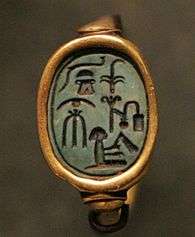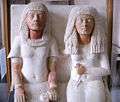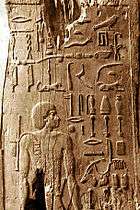Scribe equipment (hieroglyph)
The ancient Egyptian Scribe equipment hieroglyph 𓏞 (Gardiner no. Y3), or its reversed form 𓏟 (Gardiner no. Y4), portrays the equipment of the scribe. Numerous scribes used the hieroglyph in stating their name, either on papyrus documents, but especially on statuary or tomb reliefs.
| Scribe equipment in hieroglyphs |
|---|

"(The) King's Scribe",
Column 1-(left): "Overseer of the Harem, AhMose".
the central figure: "seated man with flail", is a determinative for "(seated)-Man-noble".)
(i.e. "Ah-Mes, (The)-Noble Man")
The hieroglyph depicts the 3 major components of a scribe's equipment:
- tube case – for holding writing-reeds
- leather bag – for holding colored inks (the canonical colors, black and red, mixed with water and gum)[1]
- wood scribal palette – with mixing pools; (not always made from wood)
Language usage
Often the transliteration "sesh" appears, derived from the mistaken reading sš propagated in the dictionary and books of E. A. W. Budge. This reading is found as a phonetic complement using the signs for z and š, leading to the misunderstanding. However, Old Kingdom Egyptian lacked a distinct sign for the ẖ sound and the Coptic descendant shows that the original second consonant was indeed the palatalized fricative ẖ not the (alveolo-)palatal sibilant š,[5] (š being the pool-lake-basin (hieroglyph) in the Egyptian language).
Gallery
 Meryre, a Scribe, and his wife
Meryre, a Scribe, and his wife
(hieroglyph on his pants, w/ his name) Block statue of a scribe
Block statue of a scribe
(with his name) Wood panel of scribe Hesy-Ra
Wood panel of scribe Hesy-Ra
(1 of 7 panels, Old Kingdom)- Seated scribe with part of scribe equipment on shoulders
(2-basin mixing palette over left shoulder)
Equipment, as an artifact
 Artifact
Artifact
See also
| Wikimedia Commons has media related to Scribe equipment (hieroglyph). |
| Wikimedia Commons has media related to Ancient Egyptian statues of scribes. |
References
- Betrò, 1995. Hieroglyphics: The Writings of Ancient Egypt, Scribe's Palette, p. 238.
- Loprieno (1995) p. 58
- Allen (2013) p. 53
- Bohairic-English Dictionary http://www.suscopts.org/deacons/coptic/coptdict.pdf
- Egyptologist James Allen on AEgyptian-L http://www.rostau.org.uk/aegyptian-l/archives/week608.txt
- Budge, p. 619.
- Budge, pp. 1067-1255.
- Betrò, 1995. Hieroglyphics: The Writings of Ancient Egypt, Betrò, Maria Carmela, c. 1995, 1996-(English), Abbeville Press Publishers, New York, London, Paris (hardcover, ISBN 0-7892-0232-8)
- Budge. An Egyptian Hieroglyphic Dictionary, E.A.Wallace Budge, (Dover Publications), c 1978, (c 1920), Dover edition, 1978. (In two volumes, 1314 pp, and cliv-(154) pp.) (softcover, ISBN 0-486-23615-3)
- Loprieno, Antonio, Ancient Egyptian: A Linguistic Introduction, Cambridge University Press, 1995. ISBN 0-521-44384-9 (hbk) ISBN 0-521-44849-2 (pbk)